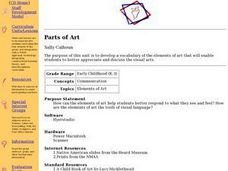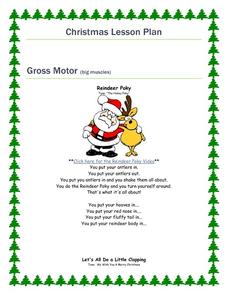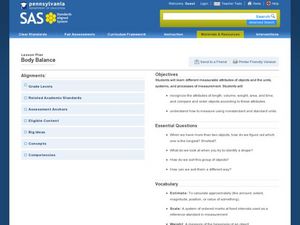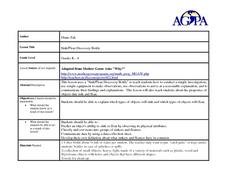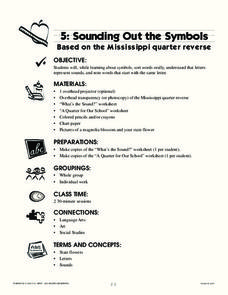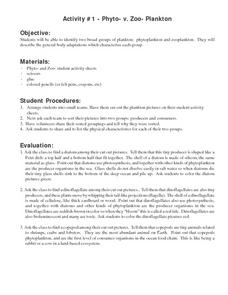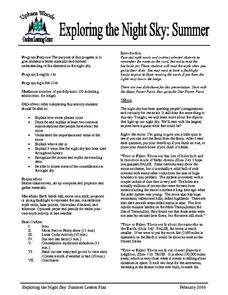Curated OER
Name that animal
A great way to classify organisms, is by counting the number of legs it has or how it moves. Little ones count the legs on five different creatures, then match the leg count to the proper animal name. Tip: Have them come up with other...
Curated OER
Parts of Art
Young scholars define and use new vocabulary associated with the elements of art. As a class, they brainstorm different ways in which we communicate with one another. In groups, they view different pieces of art from the Native American...
Early Childhood Education
Christmas Lesson Plan: Gross Motor & Fine Motor Skills
Practice gross and fine motor skills with fun Christmas- and holiday-themed activities. These holiday lessons include songs, games, and other engaging activities for both gross and fine motor skills. Kids will love pinning the nose...
Curated OER
Zany Wire Sculpture
Young artists create a freestanding 3-dimensional sculpture using wire and modeled "clay" pieces. This immensely creative and engaging lesson should get your kids excited, because the medium is unusual to work with. Everything you need...
Curated OER
Properties of Liquids
Students describe properties of liquids and use descriptive language as a springboard to develop precise vocabulary for properties of liquids. They also use vocabulary as practiced with liquid-vocabulary card games. Finally, students...
Alabama Learning Exchange
Are You a Square or a Rectangle?
Discover the difference between standard and non-standard units of measure with your class. They differentiate between rectangles and squares, read a book, measure a peer's height. They then discuss measurement methods, make...
Curated OER
Body Balance
Examine measurable characteristics of objects to build an understanding of the different ways you can discuss an object's size when comparing it to other objects. After whole group instruction, the class compares and organizes several...
Curated OER
The Fibonacci Sequence
Young scholars investigate a numerical pattern and look for evidence of mathematical patterns in nature. They solve puzzles and work with a partner to predict sequential numbers in a series.
Curated OER
Math: Matching Rods and Religion
Math and religious studies are integrated together using using cuisenaire rods and Kid Pix for this problem-solving exercise. In pairs, they match different colored rods to represent various groups of people. Meanwhile, students at...
Curated OER
Sink/Float Discovery bottle
Investigate which items float and which ones sink using this resource. Learners participate in an activity in which they investigate this phenomena. Then they describe the experimental process, and learn how to display their results.
Curated OER
Seeds in Flight Information Sheet
Seeds in flight are amazing things. Hand out a great information sheet for learners to read. They'll discover facts about seeds, why they spread, and examples of how different seeds get from here to there.
Curated OER
A Walk Around the School: Mapping Places Near and Far
After reading Pat Hutchins’ Rosie’s Walk, have your young cartographers create a map of Rosie’s walk. Then lead them on a walk around the school. When you return class members sequence the walk by making a list of how the class got from...
Curated OER
Bugs, Bugs, Everywhere!
Students collect and compare bugs using magnifying lenses and graph data based on their comparisons. In this bugs lesson plan, students also make an aspirator by using a jar, tubing, and screen.
Curated OER
Sounding Out the Symbols
Using the states as a hook, kindergartners identify beginning sounds. They identify the initial sound in words like Mississippi and Indiana and complete a set of worksheets related to this skill.
Curated OER
Fever 1793: Anticipation Guide
Introduce the themes of Fever 1793 and determine your class members’ level of background knowledge with an anticipation guide for Laurie Halse Anderson’s novel about the yellow fever epidemic that swept Philadelphia. For each prompt,...
DePaul University
The Working Tools of Insects
The animal kingdom is full of interesting organisms that have unique ways of surviving. Children read about different insects that have special tools for building homes and protecting themselves. When finished, learners identify the main...
Curated OER
Coordinate Plane
Tenth graders plot points on a coordinate plane. In this geometry lesson, 10th graders identify the different quadrants, plots points on a number line and coordinate plane and solve for the midpoint of line segments.
Curated OER
Classification
Young scholars explore the observable properties of matter and utilize them in classification. They use a binary classification system to divide objects, then justify their scheme.
Alabama Learning Exchange
The Grouchy Ladybug
Students listen to the book, "The Grouchy Ladybug" by Eric Carle and sequence the events in the story. Using a graph, they draw and color the animals that the ladybug meets next to the corresponding time from the story, and conduct...
Curated OER
Phyto- v. Zoo- Plankton
Students identify two broad groups of plankton: phytoplankton and zoo plankton. They describe the general body adaptations which characterize each group. They discuss and write about what it would be like to be carried around by the...
Curated OER
Away We Go!
Students study types of transportation. In this transportation lesson, students survey several classes to gather data on how they get to school. Students create a transportation graph.
Curated OER
Problem Solving
Second graders practice problem solving strategies. In this problem solving lesson, 2nd graders use strategies such as guess and check, acting out, drawing pictures and looking for patterns to solve problems. Students work in groups to...
Curated OER
Classifying Candy I
Students explore the observable properties of matter. They develop two binary classification systems using concrete objects. based on two different properties of the concrete objects.
Curated OER
Exploring the Night Sky: Summer
Students explain how moon phases occur. They describe and explain at least two common misconceptions that people have about the moon. Students explain what a star is. They explain 3 ways that the night sky has been used throughout history.
Other popular searches
- Classifying and Sorting Shapes
- Sorting Shapes and Colors
- Sorting Shapes by Size
- Geometry Sorting Shapes
- Sorting Shapes by Color
- Sorting Shapes Dimensional
- Sorting Shapes Worksheets
- Sorting Shapes 7 5
- Sorting Shapes by Colo
- Comparing and Sorting Shapes

